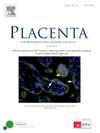The S100A11-RAGE/TLR4 axis activation mediates inflammatory response and epithelial integrity against Toxoplasma gondii infection in a human placental explant model
IF 3
2区 医学
Q2 DEVELOPMENTAL BIOLOGY
引用次数: 0
Abstract
Introduction
Toxoplasma gondii is a common zoonotic parasite that can cause serious congenital complications, such as neurological and ophthalmological disorders. While the placenta protects the fetus from pathogens, the immune response mechanisms to T. gondii are not well understood. This study focuses on how the infection affects the secretion of the host damage-associated molecular pattern S100A11, the activation of receptors RAGE and TLR4, and their role in maintaining placental barrier integrity and cytokine response against infection.
Methods
Human placental explants (HPEs) were challenged with T. gondii tachyzoites or LPS as a positive control in the presence and absence of specific inhibitors for RAGE (FPS-ZM1) and TLR4 (TAK-242). Expression of both PRRs was assayed by Western blot, RT-qPCR, and immunohistochemistry; placental damage was studied by standard histopathological methods (Hematoxylin-Eosin and Masson's Trichrome stain), expression of intercellular adhesion proteins Occludin and E-cadherin was analyzed by immunohistochemistry, the secreted DAMPs profiles by ELISA and cytokines by multiplex bead array.
Results
T. gondii infection induces the secretion and expression of S100A11 and its receptor RAGE. Inhibition of RAGE does not reduce T. gondii infection. Interestingly, simultaneous inhibition of RAGE and TLR4 decreases the parasite-induced histopathological damage of the placental barrier, intercellular proteins E-cadherin and Occludin expression, and parasite load. In addition, the secretion of IL-8, and TNF were modulated by RAGE and TLR4 inhibition.
Conclusion
These results suggest that S100A11-RAGE/TLR4 axis activation is a significant mediator of the local placental immune response against T. gondii.
在人胎盘外植体模型中,S100A11-RAGE/TLR4轴激活介导抗刚地弓形虫感染的炎症反应和上皮完整性
刚地弓形虫是一种常见的人畜共患寄生虫,可引起严重的先天性并发症,如神经和眼科疾病。虽然胎盘保护胎儿免受病原体的侵害,但对弓形虫的免疫反应机制尚不清楚。本研究主要探讨感染如何影响宿主损伤相关分子模式S100A11的分泌,RAGE和TLR4受体的激活,以及它们在维持胎盘屏障完整性和细胞因子对感染的反应中的作用。方法在RAGE特异性抑制剂(FPS-ZM1)和TLR4特异性抑制剂(TAK-242)存在和不存在的情况下,用刚地弓形虫速殖子或LPS刺激人胎盘外植体(HPEs)。采用Western blot、RT-qPCR和免疫组织化学检测两种PRRs的表达;采用标准组织病理学方法(苏木精-伊红染色和马松三色染色)检测胎盘损伤,免疫组织化学检测细胞间粘附蛋白Occludin和E-cadherin的表达,ELISA检测细胞间粘附蛋白DAMPs的表达,多重头阵列检测细胞因子表达。弓形虫感染诱导S100A11及其受体RAGE的分泌和表达。抑制RAGE不能减少弓形虫感染。有趣的是,同时抑制RAGE和TLR4可降低寄生虫诱导的胎盘屏障的组织病理学损伤、细胞间蛋白E-cadherin和Occludin的表达以及寄生虫负荷。此外,RAGE和TLR4抑制可调节IL-8和TNF的分泌。结论S100A11-RAGE/TLR4轴激活是胎盘局部抗弓形虫免疫应答的重要介质。
本文章由计算机程序翻译,如有差异,请以英文原文为准。
求助全文
约1分钟内获得全文
求助全文
来源期刊

Placenta
医学-发育生物学
CiteScore
6.30
自引率
10.50%
发文量
391
审稿时长
78 days
期刊介绍:
Placenta publishes high-quality original articles and invited topical reviews on all aspects of human and animal placentation, and the interactions between the mother, the placenta and fetal development. Topics covered include evolution, development, genetics and epigenetics, stem cells, metabolism, transport, immunology, pathology, pharmacology, cell and molecular biology, and developmental programming. The Editors welcome studies on implantation and the endometrium, comparative placentation, the uterine and umbilical circulations, the relationship between fetal and placental development, clinical aspects of altered placental development or function, the placental membranes, the influence of paternal factors on placental development or function, and the assessment of biomarkers of placental disorders.
 求助内容:
求助内容: 应助结果提醒方式:
应助结果提醒方式:


